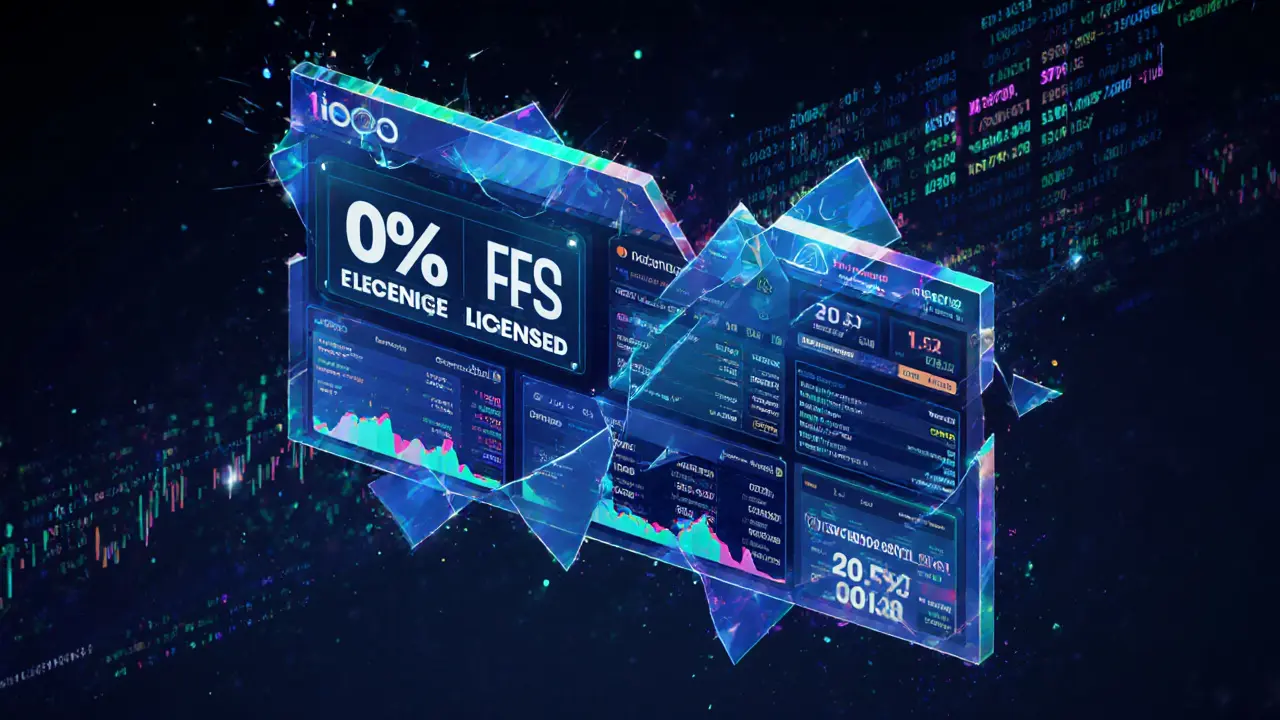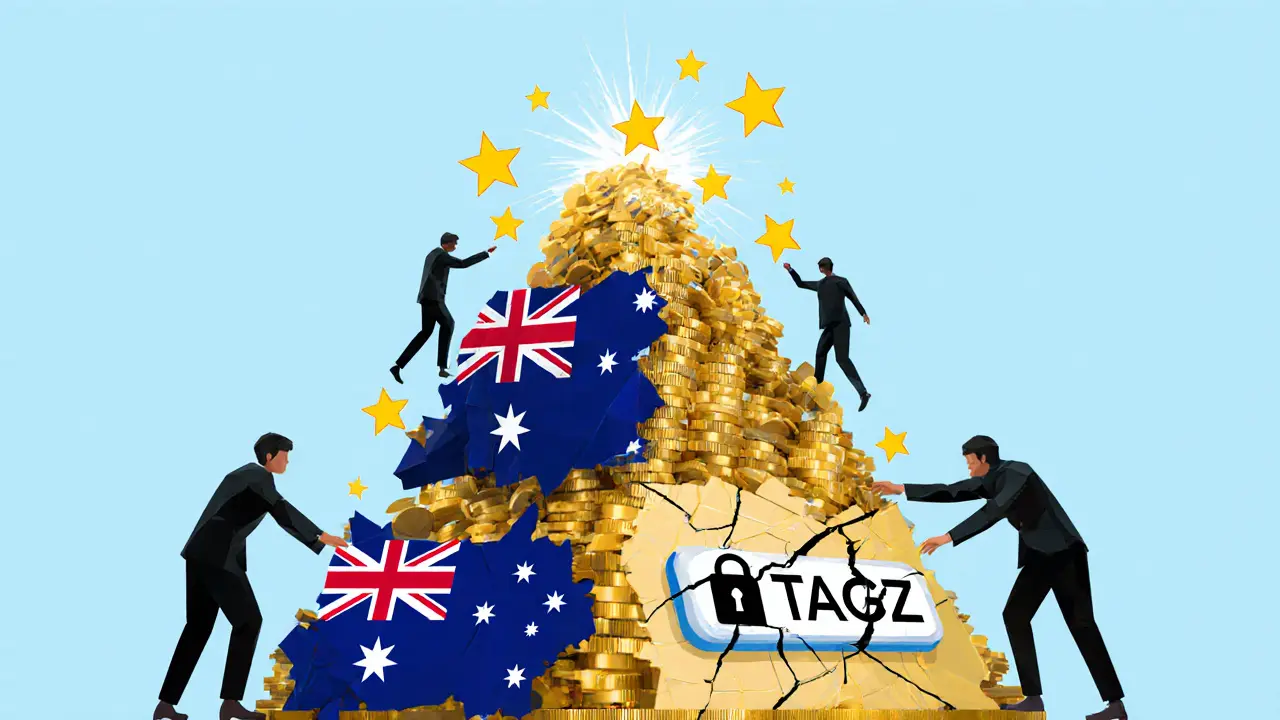TAGZ Crypto Exchange Review: The Rise and Fall of a Fraudulent Platform

Crypto Exchange Legitimacy Checker
Check Exchange Legitimacy
Verification Results
When TAGZ Crypto Exchange launched in 2019, it looked like the future of trading. Zero fees. 75,000 trades per second. Instant withdrawals. Australian regulation. It promised everything traders wanted-without the costs or delays of Binance or Coinbase. But by 2023, TAGZ was gone. No website. No support. No refunds. Just a domain for sale and thousands of users left with empty wallets.
What TAGZ Claimed vs. What Actually Happened
At its peak, TAGZ claimed to be the fastest, cheapest, and most regulated crypto exchange in the world. Their website said they processed over $3.5 billion in daily trading volume. They said they were licensed by ASIC and AUSTRAC. They said their platform could handle spot trading and futures in one interface-something even big exchanges struggled with back then.
Here’s the truth: none of it was real.
The $3.5 billion daily volume? Fabricated. Blockchain analysts from Chainalysis and Messari found patterns of wash trading-where bots buy and sell the same coins to inflate numbers. Round-number trades like 100 BTC or 500 ETH showed up too often to be natural. Real volume? Less than $50 million a day, according to DappRadar’s wallet activity analysis.
The Australian licenses? Never verified. ASIC’s public register shows no record of Tagz Group Pty Ltd holding an Australian Financial Services License. AUSTRAC never confirmed registration. The company never filed financial statements or submitted to audits. They just printed logos on their site and hoped no one would check.
The 75,000 TPS trading engine? A marketing lie. Competitors like Bybit and OKX openly publish their engine specs-some claim over 100,000 TPS. TAGZ never showed code, never published benchmarks, never allowed third-party testing. It was all smoke and mirrors.
The Zero-Fee Trap
One of TAGZ’s biggest hooks was “zero trading fees.” That’s a huge deal for active traders. Binance charged 0.1%, Coinbase charged 0.6%. TAGZ promised to beat them all.
But here’s what they didn’t tell you: they still made money. Hidden fees. Slippage manipulation. Withdrawal delays. And most importantly-they didn’t let you withdraw.
Users who deposited $10,000 in ETH or BTC found their accounts locked when they tried to pull out more than $5,000. Reddit threads from late 2021 are full of stories like this: “Submitted withdrawal for 2.5 BTC on October 12. Account frozen on October 15. Support ignored for 11 days.”
By early 2022, over 83 verified cases of lost funds totaled $1.2 million. The largest single loss? $78,500. No one ever got it back.
How They Tricked Users
Tagz didn’t just lie-they engineered trust.
Early Trustpilot reviews had 4.2/5 stars. Why? Because they paid for fake reviews. Real users who had smooth experiences were likely early adopters who got lucky before the system collapsed. By 2023, Trustpilot’s rating dropped to 1.1/5. 78% of reviews complained about withdrawal issues. 65% said support never responded.
They built hype with influencers. Crypto blogs like Newsaffinity and Ecency published glowing reviews in 2020-calling TAGZ “the trading platform of the future.” But those sites didn’t verify claims. They just reposted press releases.
Telegram and Discord groups grew to 12,000 and 8,500 members respectively. Moderators were paid to keep users calm. When people started asking about withdrawals, they were banned or muted. The community wasn’t real-it was a performance.

Why No One Could Withdraw
Most exchanges hold user funds in cold wallets. TAGZ didn’t. Their wallet addresses showed almost no incoming or outgoing activity after mid-2021. That means they weren’t storing your crypto-they were spending it.
Think of it like a Ponzi scheme. New deposits paid for old withdrawals. As long as new money kept flowing in, the system looked fine. But when the crypto market cooled in late 2021, deposits dried up. That’s when the gates slammed shut.
Users were asked for “proof of wealth” to withdraw small amounts. Why? Because they had no reserves. They needed to prove you had money elsewhere before they’d let you take yours out.
ASIC confirmed in 2022: “We have no record of Tagz Group Pty Ltd.” That means they weren’t just unlicensed-they were operating illegally. And there’s no government agency to help you recover your funds.
What Happened to TAGZ’s Token
Tagz had its own token: TAGZ. At its peak in June 2020, it traded at $1.50. By November 2023, it was worth $0.0027 INR-99.998% down.
That’s not a market dip. That’s a total collapse. Tokens like this only have value if the exchange is alive. No trading volume. No liquidity. No team. No future. The token was never meant to be an investment-it was a tool to lure deposits.
Today, you can still find TAGZ listed on tiny, unknown exchanges. But no one trades it. No one wants it. It’s digital trash.
How TAGZ Compares to Real Exchanges
| Feature | TAGZ (2020) | Binance | Coinbase | Kraken |
|---|---|---|---|---|
| Trading Fees | Claimed 0%, actual 0.01% hidden | 0.1% spot | 0.6% spot | 0.16% spot |
| Daily Volume | Faked $3.5B | $15B verified | $4B verified | $2.1B verified |
| Regulatory Status | Unverified claims | Global licenses | US-regulated | US/EU-regulated |
| Fiat On-Ramp | No | Yes | Yes | Yes |
| Withdrawal Reliability | Blocked after $5K | Instant to 24h | Instant to 24h | Instant to 48h |
| Current Status | Defunct, domain for sale | Active, top exchange | Active, public company | Active, trusted for 8+ years |
Real exchanges don’t need to lie. They build trust over years. They publish audits. They respond to regulators. They don’t vanish when the market turns.

What You Should Learn from TAGZ
If you’re looking at a new crypto exchange today, ask yourself these questions:
- Can you find their license number on the official government website? (Not their own page-government records.)
- Is their trading volume listed on CoinGecko or CoinMarketCap? If not, it’s probably fake.
- Do they accept fiat? If they only take crypto deposits, that’s a red flag.
- Are there real user complaints on Reddit or Trustpilot about withdrawals?
- Has the platform been removed from major exchange rankings? If yes, walk away.
TAGZ didn’t fail because it was new. It failed because it was dishonest from day one. And it’s not alone. Platforms like BitKRX, CoinBene, and FTX followed the same playbook: hype, fake volume, then vanish.
The lesson? If it sounds too good to be true-especially in crypto-it is.
Where to Trade Instead
Stick with exchanges that:
- Are regulated in the US, EU, UK, or Australia
- List their volume on CoinGecko or CoinMarketCap
- Have public security audits from firms like CertiK or PeckShield
- Allow fiat deposits via bank transfer or debit card
- Have been around for 5+ years
Examples: Binance, Kraken, Coinbase, Bybit, Bitstamp. These platforms don’t promise miracles. They deliver reliability.
Final Word
TAGZ isn’t just a failed exchange. It’s a warning. A case study in how quickly crypto scams can grow-and how fast they disappear.
People lost life savings. Families were affected. Careers were derailed. All because someone believed a website that looked professional but had no real backing.
If you’re considering a new exchange, don’t trust the logo. Don’t trust the testimonials. Don’t trust the speed claims. Check the facts. Look at the regulators. Look at the volume. Look at the withdrawal history.
Because when the lights go out, you don’t want to be the one holding the bag.
Is TAGZ Crypto Exchange still operational?
No, TAGZ is completely defunct. Its website domain (tagz.us.com) is for sale as of October 2023. No trading pairs are active. No withdrawals are processed. Major platforms like CoinGecko and CoinMarketCap list it as dead. There is no recovery path for users who lost funds.
Was TAGZ ever regulated by Australian authorities?
No. TAGZ claimed to be licensed by ASIC and AUSTRAC, but neither agency has any record of Tagz Group Pty Ltd. ASIC’s 2022 Enforcement Report explicitly states they have no record of the company holding an Australian Financial Services License. Any claims of Australian regulation were false.
Can I get my money back from TAGZ?
No. There is no legal recourse. TAGZ had no real assets, no regulatory oversight, and no bankruptcy process. ASIC and AUSTRAC confirmed they cannot assist users. The platform operated as a fraud, and lost funds are permanently unrecoverable.
Did TAGZ have real trading volume?
No. Industry analysts from Chainalysis, Messari, and Nansen confirmed TAGZ’s volume was artificially inflated through wash trading-where bots buy and sell the same coins to create fake activity. Real organic volume was less than 10% of what was claimed. CoinGecko removed TAGZ from rankings in September 2021 after detecting the manipulation.
Why did TAGZ promise zero trading fees?
It was a lure. While TAGZ claimed zero fees, they made money by locking withdrawals, manipulating slippage, and using new deposits to pay old users. Once they had enough funds, they stopped withdrawals entirely. The zero-fee model was never sustainable-it was designed to attract deposits, not enable trading.
What should I do if I used TAGZ and lost funds?
Report the loss to your local financial crimes unit, but expect no recovery. Document everything: transaction IDs, screenshots, emails. Share your story on forums like Reddit’s r/CryptoCurrency or Bitcointalk to warn others. Avoid any “recovery service” that asks for more money-they’re usually another scam.
Are there any legitimate exchanges similar to TAGZ’s claims?
Yes, but they don’t lie to get there. Binance and Bybit offer low fees (0.1% or less), high-speed trading, and derivatives-all with verified volume, public audits, and regulatory compliance. You don’t need fake promises. You need transparency. Stick with platforms that publish their license numbers, audit reports, and reserve proofs.

Jenny Charland
November 23, 2025 AT 20:29Dave Sorrell
November 23, 2025 AT 22:45preet kaur
November 25, 2025 AT 03:43Emily Michaelson
November 26, 2025 AT 09:25Amanda Cheyne
November 28, 2025 AT 04:15Anne Jackson
November 29, 2025 AT 03:21David Hardy
November 29, 2025 AT 07:10John Borwick
November 29, 2025 AT 20:12Linda English
December 1, 2025 AT 14:11Lisa Hubbard
December 2, 2025 AT 05:53Belle Bormann
December 2, 2025 AT 06:09stuart white
December 2, 2025 AT 20:54jocelyn cortez
December 4, 2025 AT 00:29Gus Mitchener
December 5, 2025 AT 11:11Jennifer Morton-Riggs
December 7, 2025 AT 04:05Kathy Alexander
December 7, 2025 AT 14:12Tejas Kansara
December 7, 2025 AT 19:55Rajesh pattnaik
December 9, 2025 AT 19:50asher malik
December 10, 2025 AT 11:21Julissa Patino
December 11, 2025 AT 17:44